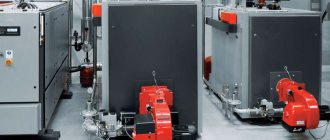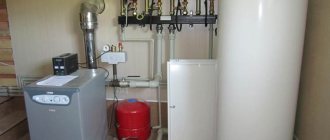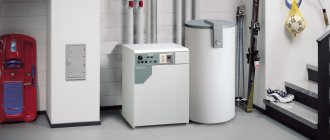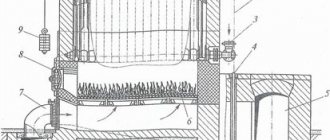Types of gas heating equipment
Equipment is classified according to the type of exhaust gas product output and types of combustion chamber. Let's look at the main types of boilers.
Chimney boilers
For their operation, a special upright chimney and air flow are required. This system has an open combustion chamber that draws air from the room. For this reason, a constant influx of fresh air masses is needed, that is, supply and exhaust ventilation. These types of boilers are quite simple in design and affordable. They are used for heating private houses, but it is necessary to place the equipment in a separate furnace room.
Prices for chimney boilers
Turbocharged systems
These boilers are equipped with a closed gas combustion chamber, so they do not use the air masses of the room.
A distinctive feature of the equipment is the presence of a turbine, which acts as a forced fan to remove combustion products, that is, carbon monoxide.
Their advantage is that the turbine rotation speed is regulated depending on the gas pressure. Consequently, the necessary pressure inside the chamber is ensured, which increases the efficiency of the boiler.
Atmospheric air enters through a coaxial chimney. It is a pipe, inside of which there is another air outlet of a smaller diameter. Atmospheric air enters through the larger radius, and combustion products are discharged through the smaller radius. The chimney is attached to a through hole in the wall. The release of air masses occurs forcibly, using a turbine.
This type of boiler is equipped with electric ignition, that is, it requires connection to the electrical network. They are more expensive compared to chimney boilers.
This is interesting ! Why you need tangit unilock and how to use it correctly is described in our article.
Parapet boilers
This type of equipment differs from turbocharged systems in that the entry and exit of air masses occurs naturally, without forced ventilation.
The similarity with turbine boilers is that they are equipped with a coaxial chimney and a closed combustion chamber.
Prices for parapet boilers
Design requirements
The installation of a smoke exhaust system must be carried out in accordance with SNiPs and GOSTs of the Russian Federation. In addition to the above SNiP 41-01-2008 and MDK 2.03.2003, it is necessary to be guided by the “Safety Rules in the Gas Industry” and SNiP 2.04.08-87*.
The following requirements apply to the design of the chimney and the procedure for connecting gas equipment to it:
- Chimney pipes must be vertical without ledges or narrowings. However, a slope of the chimney from the vertical up to 30 degrees is allowed. and deviation to the side up to 1 m.
- It is prohibited to lay chimneys through residential premises.
- Gas units are connected to chimneys using roofing steel pipes.
- You can connect several heat generators of the same type to a collective chimney (with a closed or open combustion chamber). The number of units is determined by calculation.
- It is permissible to install bends on smoke exhaust pipes, but no more than three with a radius of curvature equal to the diameter of the pipe.
- Below the connection point of the outlet pipe from the gas appliance to the chimney there should be a “pocket” with a hatch for cleaning. When operating condensing boilers, condensate drainage from the gas boiler chimney must be installed.
- If necessary, chimneys passing through unheated rooms can be covered with thermal insulation.
- The outlet pipe must be located at a distance of at least five centimeters from the ceiling or wall of non-combustible materials, and at least 25 cm from flammable structures.
- To ensure the necessary draft, the parameters of the outlet channel, including the height of the pipe and its cross-section, must correspond to the technical characteristics of the gas boiler.
- The chimney must be located outside the wind pressure zone. Its height, when located no more than one and a half meters from the ridge of the roof, should be no less than half a meter higher than the ridge.
- Where the gas duct passes through ceilings and walls, joints are not allowed.
- An umbrella and a deflector cannot be installed on the chimney of a gas boiler.
Advantages and disadvantages of parapet boilers
The design of turbine and parapet boilers is similar, but the latter have a number of advantages.
Parapet boilers: pros and cons. The positive aspects include:
- Autonomy - no connection to the electrical network is required, since ignition occurs using piezoelements (sparks), which are controlled electronically. A battery is used for power supply. The equipment can operate either from a source of constant gas supply or from a cylinder.
- Ease of installation and maintenance – turbine systems are quite complex to set up and operate. They contain various kinds of sensors and controllers. Parapet boilers are simpler.
- Versatility - you can connect the equipment to a radiator system, but the boiler itself can become a heat source (through convection windows). Suitable for heating small houses and apartments. There are wall-mounted and floor-mounted models. Their compact dimensions allow them to be installed in any convenient location, subject to certain operating conditions.
- A closed combustion chamber does not take oxygen from the room - to summarize, a parapet boiler is a simplified version of turbine equipment, while maintaining quality characteristics, at an affordable price.
Experts also note certain disadvantages. Unlike turbo systems, air is forced into the pipe naturally, so the inlet pressure is lower. To improve functionality, parapet boilers are installed with built-in circulation pumps, which are connected to an electricity source, or they are battery-powered. Sometimes, in severe frosts, the outlet pipe may freeze.
Advantages and features of parapet units
The main advantage of the equipment is its compactness: a parapet boiler running on gas can easily fit in the kitchen under a window sill or in any other room, since during operation it does not consume oxygen from the room and does not pose a danger to residents. A coaxial chimney is a reliable and safe smoke removal system, which also offers a choice in favor of such equipment.
The correct choice of product should be based on the following parameters (except for consumer reviews and catalogs from selling companies):
- Installation technology: the parapet boiler is made for mounting on walls and floors; there are also left- and right-hand models;
- A gas parapet boiler can be equipped with one or two circuits. One circuit is for heating only, the second circuit is for domestic hot water;
- Also, parapet boilers can be energy-dependent (with an automatic monitoring, adjustment and control system) and non-volatile (with or without manual adjustment).
Technical characteristics of universal boilers
The thermal power possessed by parapet boilers varies between 15 kW-40 kW for a unit with one circuit. If you choose to install parapet equipment with two water heating circuits, then the capacity for heating water for domestic needs should also be added to the rated power. For example, parapet boilers with a power of 12 kW -15 kW easily heat the volume of water up to 180 l/h, which, according to the standards, is four water points (faucets, toilets, faucets, showers, etc.).
- The single-circuit unit has a standard heat exchanger (jacket) of a plate design, which speeds up the process of heat exchange between the gas burner and the working fluid of the heating system. The material of the shirt is thick 3 mm steel.
- Double-circuit gas parapet boilers contain, in addition to the heat exchanger, a copper or brass coil for hot water supply, in which water is heated only by the flow method. If you increase the productivity of the hot water supply due to an additional hot water tank, then such a boiler will no longer be able to be installed in the kitchen.
Also, in addition to wall-mounted and floor-mounted models, there are products with differences in installation: with left-side connection of the gas pipe, hot water supply and heating circuit, and with right-side connection. This convenience should not be overlooked when choosing a boiler for an apartment or house. The dimensions of the unit are determined by its performance and the number of water heating circuits. For example, if a boiler has one circuit, then its dimensions will be smaller than that of a double-circuit one.
Types of boilers by power
What are the types of parapet boilers?
Ease of installation and control, versatility, combined with a fairly low cost, have made these boiler models quite popular among the population.
Types of boilers according to different indicators and criteria:
- Gas parapet boilers, single-circuit and double-circuit. The first ones have one circuit, only for heating. The second are two circuits: for heating and water heating.
- The place in which they are installed: parapet gas heating boilers, floor-mounted, wall-mounted. The floor can be placed under the window, in the kitchen, or in another convenient place of non-permanent residence.
- Equipment is distinguished according to the output of pipes for connection to heat carriers: left-handed, right-handed.
- Wide power range. Depending on the heated area, you can choose equipment with a power from 7 to 60 W. They make a calculation (on average): 1 W per 10-15 sq. m. This run-up is explained by heat loss from walls, windows, as well as the climatic conditions of the region. The greater the heat loss, the greater the boiler power required. If, for example, you need to install a wall-mounted parapet gas boiler, it is better to invite a specialist for consultation who will make the calculations. It is also necessary to insulate the walls as much as possible and replace conventional windows with energy-saving ones.
- Methods for removing combustion products may be different. In private houses it is possible to use conventional chimneys with good draft. But first you need to decide which type of equipment is better, a parapet or chimney boiler. Then, as in apartments, only a coaxial chimney is possible.
- Pressurized burners in boilers come in different types (single-stage, two-stage, modeling).
- They vary according to the heat source. Heating comes directly from the boiler, through convection holes. In most cases, the equipment is connected to radiator-type devices. This could be a pipe that runs around the perimeter of the house.
- Autonomy from power supply plays an important role, especially for country houses. It is better if the boiler ignition is battery powered. In this case, the heat supply will not depend on power outages.
Models have different configurations with controllers, including:
- flame sensor, automatically turns off the gas if the flame goes out;
- the thermostat regulates the water temperature and turns off the system if t rises to critical;
- the blocking system is triggered when the pressure drops critically or the gas is turned off;
- traction controller.
These various parameters allow you to choose the optimal model for heating the room.
Installation process
Installation of a parapet gas boiler is carried out in the following steps:
- If the covering of the wall on which the device will be hung is flammable, it should be removed at least in an area equal to the projection of the boiler onto the wall.
- A hole is made in the wall in accordance with the diameter of the chimney. It is necessary to ensure that the pipe is placed with a slight slope towards the street to remove condensate.
- A coaxial pipe is inserted into the resulting hole and fixed. The presence of a certain slope should be checked. For example, for a wall of one and a half bricks, the outside of the pipe should be 4 mm lower than the inside.
- In accordance with the position of the installed chimney, places for fastenings are marked on the wall. Then the holes are drilled and the fasteners are installed on the wall.
- The boiler, depending on the model, is hung on the wall or installed on the floor.
- The pipe connection is attached to the unit. Heating sections are being installed.
- Heating and water supply pipelines are supplied to the boiler nozzles (depending on the model).
- The gas connection to the device and the first start-up must be carried out by a gas specialist.
Depending on the unit model, some installation points may differ slightly.
Note! In order for the heat exchanger of the parapet unit to work as long as possible, it is recommended to install a filter on the tap water inlet pipe.
Construction of gas equipment and principle of operation
Parapet boiler, what it is, how it works. Design features depend on power, number of circuits and other parameters.
Device
Main elements of the boiler:
- Protective housing, casing inside it. There are convection holes on their surfaces. Thanks to their presence, a radiator is not installed in the room where the boiler is located.
- Gas burner design unit (ignition, gas valve, burners).
- Heat exchangers .
A double-circuit parapet gas boiler has two types of heat exchangers: one, more voluminous, for heating; the other is for heating water. - The combustion chamber itself is a closed, sealed type.
- The chimney is coaxial or a straight pipe (installation is possible only in private houses).
- Circular pump, controllers, sensors.
Operating principle of a parapet gas boiler
With the help of a piezoelectric element, the pilot burner is ignited; it is in working order while the boiler is operating.
Then the gas supply valve opens and the linear burners are lit. Warm flows emanating from the main burners heat the heat exchangers. They are made from metals that do not corrode, for example, copper, cast iron. Its thickness should be optimal for the strength of the structure, but at the same time, the element should have time to warm up and give off heat (on average 3-4 mm).
Water passes through the walls of the heat exchanger, it heats up, then supplies heat to radiators of various types.
When the set temperature is reached, the main burners are switched off. The pilot plant is in standby mode. If the sensor shows a temperature drop below the set mode, the linear burners light up and a new heating cycle begins.
Air is supplied through the coaxial chimney to maintain gas combustion and remove combustion products, as well as condensate. The device of a parapet gas boiler with two circuits additionally uses the heat of exhaust gases, which increases its performance.
A circular pump stimulates the movement of coolants through the system. It is relevant for the operation of fairly long heating mains.
Installation Requirements
If the basic installation requirements are not met, this may result in complaints from the neighbor. Combustion products have a special odor and are harmful to human health. Also, violation of the requirements may affect the stability of the equipment - the unit may regularly go out, not light up, or smoke. These shortcomings are corrected by re-installation with the involvement of professionals.
Boilers should be placed on the external walls of the house. The distance from the facade is from 0.3 to 3.0 meters (the indicator depends on the power of the boiler). The chimney is installed only in open rooms. The wall intended for installation should be treated with non-flammable and fire-resistant materials.
Boilers should never be installed dangerously close to upholstered furniture, curtains or other flammable materials. The room where the equipment will be installed must be equipped with a high-quality ventilation system. The power of the unit is selected according to the size of the house that needs to be heated.
Do-it-yourself installation of a parapet gas boiler
It is necessary to begin the installation of heating equipment by carefully studying the instructions and safety rules described in it. It must also be remembered that the commissioning of the boiler is approved by gas services. If you installed the boiler yourself, then involve specialists in consultation to complete the correct installation.
The process takes place in several stages.
Installation conditions
First, choose the optimal location for installing the boiler, in accordance with existing standards.
The equipment is installed only in premises that are classified as non-residential (kitchen, hall, utility rooms).
The outlet for the chimney pipe must be located on an external surface that is resistant to fire. In most models, it comes with a metal casing. It is attached directly around the diameter of the pipe outlet on the outer wall. If there are elements on the chimney outlet wall that can ignite when heated, then the distance to them should be at least 20-35 cm.
It is strictly forbidden to lead the chimney onto balconies and loggias, into passage arches, especially into the entrance. It must be remembered that toxic combustion products are removed.
It is prohibited to install the exhaust chimney near the supply ventilation intakes (distance from 60 cm - for low-power boilers; up to 1.5 meters - for equipment with a power of over 7 W). If the inlet ventilation and chimney are located close together, exhaust gases may enter the supply ventilation ducts.
Periodically, the chimney will need to be cleaned, so it would be more correct to place it in a place where it can be accessed, for example, under a window.
For the first floors, it is preferable to install a mounted boiler, approximately at a height of 2-2.2 meters.
Indoors, flammable surfaces must not be placed closer than 30 cm around the boiler (upholstered furniture, curtains, tulle).
There must be access to the system from all sides, at least one meter.
Important!
Failure to comply with these requirements may result in gas services prohibiting the boiler from being put into operation.
Boiler installation
You will need the following tools: a diamond drill for making a hole in the wall, boiler fasteners, a level, caps (shut-off valve), an adjustable wrench.
Installing a parapet boiler with your own hands requires certain practical skills.
Sequencing:
- First, a hole is punched in the wall, the size of the outer diameter of the chimney. For this purpose, special diamond drills with a diameter of 240-270 mm are used.
- Then the outer contour of the coaxial pipe is installed. The chimney is installed at an angle of 4-5 mm to allow condensation to drain.
- Next, fasteners for the mounted boiler are screwed in and markings are made for the floor section.
- Install a water supply system and gas outlet.
- The internal chimney pipe is fixed.
- Install the boiler, connect the water and gas connections to it, and the heating system pipes.
Attention!
All connections must be installed as correctly as possible, correct fit and maximum compatibility of all joints must be monitored.
The last stage will be the control launch of the boiler. It is more correct to carry it out in the presence of a specialist. Make sure that the flame is even, there is a special viewing window for this. Check to see if the gas has leaked or water has leaked at the joints.
Most common problems
A parapet floor-standing gas boiler, like a wall-mounted one, can sometimes go out.
The most common reasons:
- Icing of the external chimney unit. In this case, the access and removal of air is disrupted. It is recommended to try starting the boiler at minimum power and try to warm it up in this way. Or carefully knock off the ice.
- When using boilers of all types, it is advisable to install water purification filters. If it is hard enough, the heat exchanger system may clog. In this case, you need to disconnect it and clean it.
- When there is a strong gusty wind, sometimes its gusts enter the exhaust chimney (backdraft), which leads to the flame being blown out.
- The fire may go out if there is insufficient gas pressure. The cause must be eliminated; there may be a leak.
- Failure of various sensors and controllers. Replacement or repair of boiler parts is required.
If it is difficult to determine the cause yourself, there is not enough knowledge or experience, it would be more correct to invite a specialist to repair it.
Rating of the best manufacturers
Gas double-circuit parapet boiler, which manufacturer is better, what to focus on. It is necessary to analyze the rating of parapet gas boilers and read reviews.
Imported parapet gas boilers. Among them, it is worth highlighting equipment with cast iron heat exchangers, their advantage is reliability, with a power of 12 to 60 W. They will be able to heat larger houses and apartments. A distinctive feature of this kind of heat exchangers is their resistance to temperature changes and mechanical deformation. Thus, the Electrolux company produces equipment that can withstand critical temperatures above 90 degrees.
It should be noted the high-quality products of such companies: Italian - Fondital, Beretta; Slovak – Alphatherm Beta, Attack; Hungarian - Alphatherm Delta.
Russian parapet gas boilers. Domestic manufacturers often use components from the CIS and EU countries to manufacture equipment. These are cast iron heat exchangers, sensors, controllers. Thus, while maintaining quality characteristics, the final cost is reduced to approximately 15%.
This type of product includes: “Titan N” boilers (Ryazan); Lemax Leader GGU-ch (Taganrog); Siberia KCHGO (ZAO Rostovgazoapparat). These models are distinguished by a wide range of equipment power. Manufacturers offer single-circuit and double-circuit boilers of various types.
It is worth noting the high-quality products of Russian companies Helios, Danko, Conord.
We can conclude that parapet gas boilers are universal equipment for heating a home, which combines high quality indicators (efficiency 93-95%) and optimal prices. They compare favorably with chimney models with an open gas chamber in that they do not require a separate room for a boiler room. At the same time, compared to turbocharged models, it is easier to operate. The advantageous aspect of this type of equipment is its independence from the power supply system. This makes it possible to install the boiler in areas where there is a risk of power outages.










